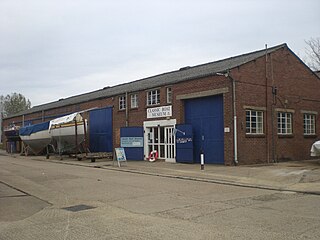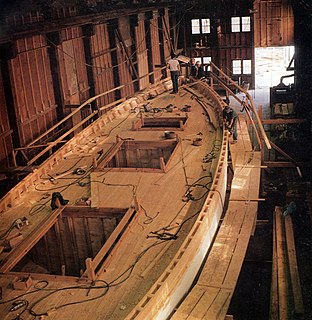
The National 12 is a two-person, two-sail, twelve-foot long sailing dinghy. They are sailed extensively in the UK. The class was started in 1936 by the Royal Yachting Association as an alternative to the more expensive International 14s.

The Cornish pilot gig is a six-oared rowing boat, clinker-built of Cornish narrow-leaf elm, 32 feet (9.8 m) long with a beam of 4 feet 10 inches (1.47 m). It is recognised as one of the first shore-based lifeboats that went to vessels in distress, with recorded rescues going back as far as the late 17th century. The original purpose of the Cornish pilot gig was as a general work boat, and the craft is used as a pilot boat, taking pilots out to incoming vessels off the Atlantic Coast. At the time pilots would compete between each other for work; the fastest gig crew who got their pilot on board a vessel first would get the job, and hence the payment.

Nathanael Greene Herreshoff was an American naval architect, mechanical engineer, and yacht design innovator. He produced a succession of undefeated America's Cup defenders between 1893-1920.

Vigilant was the victorious United States defender of the eighth America's Cup in 1893 against British challenger Valkyrie II. Vigilant was designed by Nathanael Greene Herreshoff and built in 1893 by the Herreshoff Manufacturing Company of Bristol, Rhode Island. She was Herreshoff's first victorious America's Cup defender design.
Fairey Marine Ltd, latterly known as FBM Marine, was a boat building company based on the River Hamble, Southampton, England. The company was created in the late 1940s by Sir Charles Richard Fairey and Fairey Aviation's managing director, Mr. Chichester-Smith. Both were avid sailing enthusiasts along with Chichester-Smith's good friend and former Olympic yachtsman, Charles Currey.

His Majesty's Yacht Britannia was a racing yacht built in 1893 for RYS Commodore Albert Edward, Prince of Wales. She served both himself and his son King George V, with a long racing career.
The Bristol Classic Boat Company is a boat building and restoration company based at Bristol's Floating Harbour, England.

Hunter Boats Limited is a British boat builder presently based in Southampton. The company specializes in the design and manufacture of fiberglass sailboats.
Alfred Mylne (1872–1951) was a Scottish yacht designer, born in Glasgow. He founded A Mylne & Co. in 1896.

Alexander Robertson started repairing boats in a small workshop at Sandbank, Argyll in 1876, and went on to become one of the foremost wooden boat-builders on Scotland's River Clyde. The 'golden years' of Robertson's yard were in the early 1900s when they started building some of the first IYRU 12mR & 15mR racing yachts. Robertson's was well known for the quality of its workmanship and was chosen to build the first 15-metre yacht designed by William Fife III. More than 55 boats were built by Robertson's in preparation for the First World War and the yard remained busy even during the Great Depression in the 1930s, as many wealthy businessmen developed a passion for yacht racing on the Clyde. During World War II the yard was devoted to Admiralty work, producing a wide range of large high speed Fairmile Marine Motor Boats. After the war the yard built the successful one-class Loch Longs and two 12-metre challengers for the America's Cup: Sceptre (1958) and Sovereign (1964). Due to difficult business conditions the Robertson family sold the yard in 1965, and it was turned over to GRP production work until it closed in 1980. During its 104-year history, Robertson's Yard built 482 numbered boats, many of which are still sailing today.

Nahlin is a luxury yacht and one of the last of three large steam yachts constructed in the UK. She was built for Lady Yule, heiress of Sir David Yule, and was launched in 1930. She is owned by British industrial entrepreneur Sir James Dyson, who purchased her from Sir Anthony Bamford, Chairman of JCB. The name Nahlin is taken from a Native American word meaning "fleet of foot" and the yacht has a figurehead depicting a Native American wearing a feathered headdress beneath the bowsprit.

The Classic Boat Museum is a museum of boats and of the history of yachting and boating. It is located on the Isle of Wight at two separate sites on either side of the River Medina; The Boat Collection in Cowes, and The Gallery in East Cowes. It is a working museum featuring restoration. Work takes place all year round. In addition to classic boats, the museum contains tools, artefacts, books, photographs, film and archival items that relate to the history of boat building, sailing, yachting, cruising and racing over the last century.

Bloodhound is a 19.2-metre (63 ft) ocean racing yacht. She was designed by Charles E. Nicholson and built by Camper and Nicholsons in 1936. From 1962 to 1969 she was owned by the British Royal Family and in January 2010 she was purchased by The Royal Yacht Britannia Trust.

Luke & Co was a boatbuilding firm, established in 1829 in Limehouse near London. They moved to Oakbank at Itchen Ferry in 1868, and in 1895, settled at Hamble. At Hamble, they designed and built yachts of all sizes, as well as providing all kinds of services to the yachts visiting or having a berth at the river. The river Hamble was a popular place to "lay up" yachts for the winter.
In the 1950s, together with a variety of designs of dinghies, Fairey Marine Ltd produced larger sailing cruisers, the Atalanta, Titania, and Fulmar, also the 27' Fisherman motor sailer. They also made the 15' Cinderella / Carefree, and the 16'6" Faun.
Frederick Shepherd (1869–1969) was an English boat designer. He designed 84 yachts over his 45-year career, and usually supervised the construction of each yacht. This may account for the relatively small number of designs over a long career of designing yachts. Unusually amongst yacht designers of the time, his principal focus was cruising yachts rather than racing yachts. His focus on cruising rather than racing meant that he became known for yachts which had attractive lines and better space down below than their racing equivalents.
The Tumlare is a class of canoe-sterned yacht designed by Knud Reimers. The design dates from the early 1930s. The Tumlare is 8.30 metres (27.2 ft) overall; the design was strongly endorsed as a 'very advanced type' by Uffa Fox who was especially interested in the composite method of construction employed, with metal frames interspersed between the timber ones.
Dolly Varden was a British racing yacht.
















